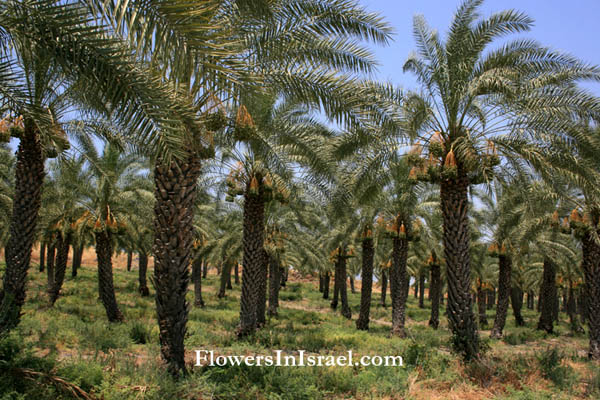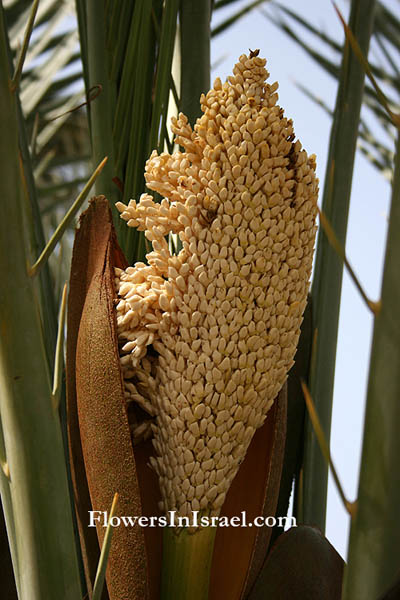
Derivation of the botanical name:
Phoenix, Greek name for the date palm, used by Theophrastus, indicating that the tree was first introduced to the Greeks by the Phoenicians.
dactylifera, Greek dactylos δακτυλοϛ, finger, toe; Latin fero, I bear; bearing fingers, furnished with fingers.
The name “Phoenicia” (Hebrew: “Tzidon”) by which part of the Levant (the Eastern Mediterranean), particularly the portion including Tyre and Sidon, was known to the Greeks and Romans, which means the land of palms.
Phoenicians have not, like the Hebrews, left us their own written record of their past. Hence we know of the Phoenicians chiefly from their enemies, from what was said of them in the writings of later Egyptians, Greeks, and Romans.
The Hebrew name: תמר, tamar; Aramaic: תמרא, tamara; Arabic: tamr. It became the Jews’ symbol of grace and elegance and was often bestowed by them to women, as, for instance, the daughter of King David, (sister of Absalom) in allusion to their graceful upright carriage.
Greek, Φοῖνιξ, Phoenix.
- The standard author abbreviation L. is used to indicate Carl Linnaeus (1707 – 1778), a Swedish botanist, physician, and zoologist, the father of modern taxonomy.
Phoenix dactylifera is one of mankind's oldest cultivated plants. It is believed to have originated around the Persian Gulf, and has been cultivated since ancient times from Mesopotamia to prehistoric Egypt, possibly as early as 4000 BCE.
In the Second Temple Period, the palm was a symbol of victory: "They came to the fort in Jerusalem with praise and with date fronds and with lyres and with harps," the Book of Maccabees, following a Jewish victory over the Greeks.
The fronds (=the leaf or leaflike part of a palm) are reminders of the Jewish people's 40-year wandering in the desert - Date palms also appeared on Jewish victory coins of that period.
Herodotus (ca. 484 BCE - ca. 425 BCE),[1,193] in a description of Babylonia sys: "Palm-trees grow in great numbers over the whole of the flat country, mostly of the kind which bears fruit, and this fruit supplies them with bread, wine, and honey. They are cultivated like the fig-tree in all respects, among others in this. The natives tie the fruit of the male-palms, as they are called by the Greeks, to the branches of the date-bearing palm, to let the gall-fly enter the dates and ripen them, and to prevent the fruit from falling off. The male-palms, like the wild fig-trees, have usually the gall-fly in their fruit."
Publius Cornelius Tacitus (l. c. 56 - c. 118 CE), a Roman historian, notes in The Histories by Tacitus, Book Five, 6 the growth of the palms in Judea.
The palm groves of Ein Gedi. In the Bible, the Dead Sea oasis, is sometimes referred to as Hazazon Tamar—tamar is Hebrew for date palm, a large number of which still grow around the modern-day kibbutz and nature preserve. There’s also a reference to “the vineyards of Ein Gedi” in the Song of Songs.
Jericho is described in the Hebrew Bible as the "city of palm trees"(Deuteronomy 34:3).The palm was taken by the Hebrews as a symbol of the righteous man.
Psalm 92:12: "The righteous shall flourish like the palm tree: he shall grow like a cedar in Lebanon".
The date palm was one of the most ancient symbols of the Tree of Life and an emblem of triumph and victory.
In the Bible, the Tree of Life was located at the centre of the Garden of Eden, the birth-place of Man, where divine order ruled over all living beings. Contrasting with it was the“Tree of the Knowledge of Good and Evil,” with its forbidden fruits, which ultimatelyinduced the fall of Man.
Phoenix dactylifera, the date palm, was one of the most ancient symbols of the Tree of Life and an emblem of triumph and victory. In North Africa, Arabia, and the Middle East, dates were a traditional food; an oasis full of date palms must have looked like a sight of Heaven when caravans, after days or weeks in the desert, reached its vicinities. Palms were often offered to winners as an emblem of victory and triumph, the palm was also seen as a favorable omen in legends of the origins of Rome. Publius Ovidius Naso (43 BCE – 17/18 CE), known as Ovid, a Roman poet who lived during the reign of Caesar Augustus (63 BCE – 14 CE), tells that Rhea Silvia, before giving birth to Romulus and Remus, saw her future sons in a dream, in the form of palm trees with majestic fronds rising up to the sky. Christians assimilated this ancient practice and received Christ in Jerusalem with palm leaves as He triumphantly entered into the city. This ritual is repeated every year prior to Easter, on Palm Sunday, as a remembrance symbol. In religious paintings the palm leaf was adopted as a symbol of martyrdom, usually depicted with martyr saints who overcame death and are examples of triumph through self-sacrifice.
The Lulav (Hebrew: לולב)
is one of the Four Species (arba'ah minim - ארבעה מינים; Leviticus 23:40) used in the daily prayer services during the Jewish holiday of Sukkot. It is a ripe, green, closed frond of the date palm tree - Palm trees love hot and dry climates, but they don’t give much fruit along the coast, where it may be hot in the summer but it’s also very humid, they prefer the deserts.
Dates are naturally wind pollinated which requires about an equal number of male and female plants. In modern commercial horticulture pollination is entirely manually and one male can pollenize up to 50 females. Since the males are of value only as pollenizers, this allows the growers to use their resources for many more fruit producing female plants. Some growers do not even maintain any male plants as male flowers become available at local markets at pollination time.
There are three main fruit types: soft, semi-dry, and dry. The type of fruit depends on the glucose, fructose and sucrose content.
Dates pass through four stages of development known by their Arabic names; Kimri (unripe), Khalaal (full-size, crunchy), Rutab (ripe, soft), and Tamer (ripe, sun-dried).
- Kimri: In this stage, the average fruit length is about 27mm and its diameter is about18mm.The average weight of dates is5.8g. Dates in this stage contain an average of 5.6% protein, 0.5% fat, and 3.7% ash.
- Khalal: The color of the date changes from green to somewhere between yellow and red depending on the cultivar(3–5weeks),the average fruit length increases up to 32mm and its diameter increases up to 21mm. The percentages of protein, fat, and ash decrease to 2.7%, 0.3% and 2.8%, respectively.
- Rutab: The date begins to soften and lose water (2–4 weeks). The protein,fat, and ash percentages in this stage decrease to 2.6%, 0.3%, and 2.6%, respectively.
- Tamr: The date has now dried to afirm consistency with darker color but there are types of dates that do not develop to this stage. The average percentages of protein, fat, and ash in the Tamr stage are 2.3%, 0.2%, and 1.7%, respectively.
Different species of date palms, were imported (smuggled) into Israel from Iraq by Israel Ben Zion (1887-1954) from Kvutzat Kinneret. The palm branches smuggled from Iraq were of the Khadrawy, Sair / Sayer and Hallawi species.
Sair- semi dry dark brown date; its semi dryness promotes preservable of the date. High level of sugar, redundant juice, easily separations of core date.
Khadrawy- A small dark mahogany date with a dry flaky skin. Originally from Iraq, they have a high moisture content, less sugar, and a mild flavor.
Hallawi- A medium sized, soft golden brown date, with a rich creamy sweet flavor, and a caramel like texture. Originally from Iraq, Halawi means sweet.
The more common plant species in Israel today are fruitful species brought from North Africa.
W.H. Barreveld, [Date Palm Products (FAO Agricultural Services Bulletin No. 101, Food and Agriculture Organization of the United Nations, Rome 1993)], describes the four stages of dates growth: Hababauk is the term used for the female flower and the period just after pollination when the young fruit is still creamy white before gradually turning green at the utab stage. At the utab stage there is a rapid increase in size, weight, and reducing sugars; it is the period of highest acid activity and moisture content (up to 85%). All factors level off at the end of this stage when the fruit starts to turn yellow (or red according to variety). At this point the date seed could already germinate and the fruit is botanically mature. At the khalaal stage weight gain is slow but sucrose content increases, moisture content goes down, and tannins will start to precipitate and lose their astringency. In some varieties this latter process evolves rapidly, which makes them already palatable at the khalaal stage, and one could speak of commercial maturity for this type of fruit at this stage. With (normally) the tips of the fruit starting to turn brown, the utab stage sets in which is characterized by a decrease in weight due to moisture loss, a partial (the degree depending on the variety) inversion of sucrose into invert sugar and a browning of the skin and softening of the tissues. The moisture content goes down to about 35% and the dates at this stage are sold as fresh fruit. Only when the dates are left to ripen further on the palm will they turn into tamr, climatic conditions permitting, characterized by a moisture content at which the date is self-preserving. The upper limit for the date to be self-preserving lies at around 24-25%. Dates distinguish themselves therefore from most other fruit in that they have a botanical maturity and at least 3 distinct commercial maturation levels, the sweet khalaal, the utab, and the tamr stage.
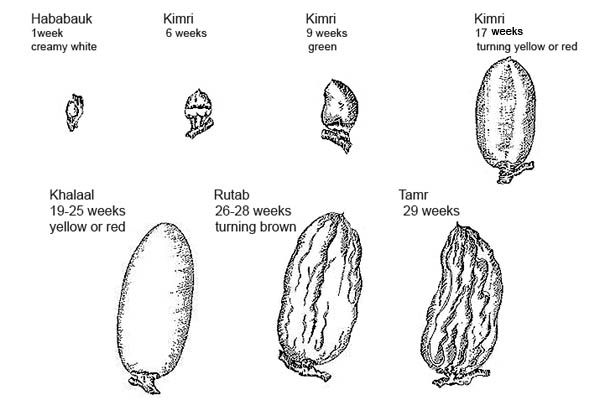
Date formation
BIBLICAL REFERENCES:
- Then they came to Elim, where there were twelve springs and seventy palm trees, and they camped there near the water.
Exodus 15:27
- On the first day you are to take choice fruit from the trees, and palm fronds, leafy branches and poplars, and rejoice before the LORD your God for seven days.
Leviticus 23:40
- They left Marah and went to Elim, where there were twelve springs and seventy palm trees, and they camped there.
Numbers 33:9
- the Negev and the whole region from the Valley of Jericho, the City of Palms, as far as Zoar.
Deuteronomy 34:3
- The descendants of Moses' father-in-law, the Kenite, went up from the City of Palms with the men of Judah to live among the people of the Desert of Judah in the Negev near Arad.
Judges 1:16
- Getting the Ammonites and Amalekites to join him, Eglon came and attacked Israel, and they took possession of the City of Palms.
Judges 3:13
- Then he gave a loaf of bread, a cake of dates and a cake of raisins to each person in the whole crowd of Israelites, both men and women. And all the people went to their homes.
2 Samuel 6:19
- On the walls all around the temple, in both the inner and outer rooms, he carved cherubim, palm trees and open flowers.
1 Kings 6:29
- And on the two olive wood doors he carved cherubim, palm trees and open flowers, and overlaid the cherubim and palm trees with beaten gold.
1 Kings 6:32
- He carved cherubim, palm trees and open flowers on them and overlaid them with gold hammered evenly over the carvings.
1 Kings 6:35
- He engraved cherubim, lions and palm trees on the surfaces of the supports and on the panels, in every available space, with wreaths all around.
1 Kings 7:36
- Then he gave a loaf of bread, a cake of dates and a cake of raisins to each Israelite man and woman.
1 Chronicles 16:3
- He paneled the main hall with pine and covered it with fine gold and decorated it with palm tree and chain designs.
2 Chronicles 3:5
- The men designated by name took the prisoners, and from the plunder they clothed all who were naked. They provided them with clothes and sandals, food and drink, and healing balm. All those who were weak they put on donkeys. So they took them back to their fellow countrymen at Jericho, the City of Palms, and returned to Samaria.
2 Chronicles 28:15
- and that they should proclaim this word and spread it throughout their towns and in Jerusalem: "Go out into the hill country and bring back branches from olive and wild olive trees, and from myrtles, palms and shade trees, to make booths"-as it is written.
Nehemiah 8:15
- The righteous will flourish like a palm tree, they will grow like a cedar of Lebanon;
Psalm 92:12
land flowing with milk and honey - the original honey actually refers to the syrup produced from the juice of the date.
- So I have come down to rescue them from the hand of the Egyptians and to bring them up out of that land into a good and spacious land, a land flowing with milk and honey—the home of the Canaanites, Hittites, Amorites, Perizzites, Hivites and Jebusites.
Exodus 3:8
- And I have promised to bring you up out of your misery in Egypt into the land of the Canaanites, Hittites, Amorites, Perizzites, Hivites and Jebusites—a land flowing with milk and honey.'
Exodus 3:17
- When the LORD brings you into the land of the Canaanites, Hittites, Amorites, Hivites and Jebusites—the land he swore to your forefathers to give you, a land flowing with milk and honey—you are to observe this ceremony in this month:
Exodus 13:5
- Go up to the land flowing with milk and honey. But I will not go with you, because you are a stiff-necked people and I might destroy you on the way."
Exodus 33:3
- But I said to you, "You will possess their land; I will give it to you as an inheritance, a land flowing with milk and honey." I am the LORD your God, who has set you apart from the nations.
Leviticus 20:24
- They gave Moses this account: "We went into the land to which you sent us, and it does flow with milk and honey! Here is its fruit.
Numbers 13:27
- If the LORD is pleased with us, he will lead us into that land, a land flowing with milk and honey, and will give it to us.
Numbers 14:8
- Isn't it enough that you have brought us up out of a land flowing with milk and honey to kill us in the desert? And now you also want to lord it over us?
Numbers 16:13
- Moreover, you haven't brought us into a land flowing with milk and honey or given us an inheritance of fields and vineyards. Will you gouge out the eyes of these men? No, we will not come!"
Numbers 16:14
- Hear, O Israel, and be careful to obey so that it may go well with you and that you may increase greatly in a land flowing with milk and honey, just as the LORD, the God of your fathers, promised you.
Deuteronomy 6:3
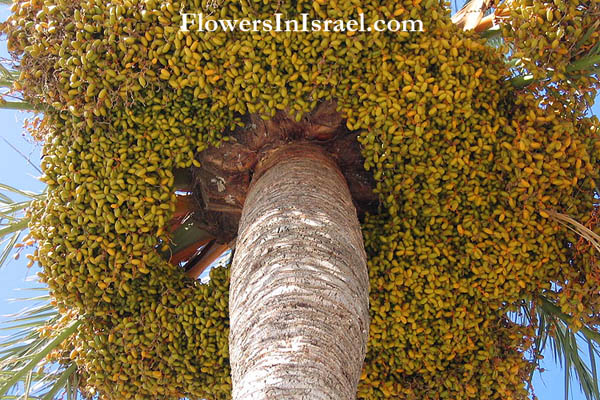
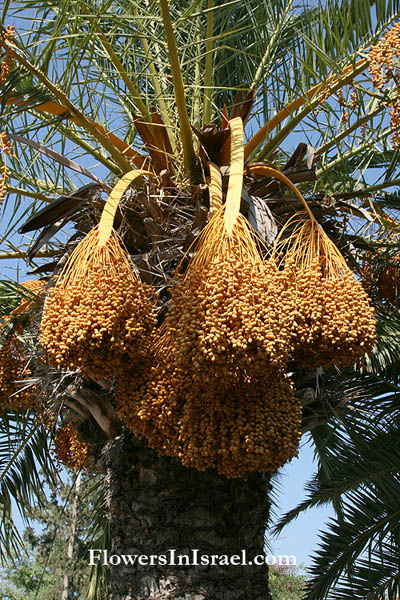
|
